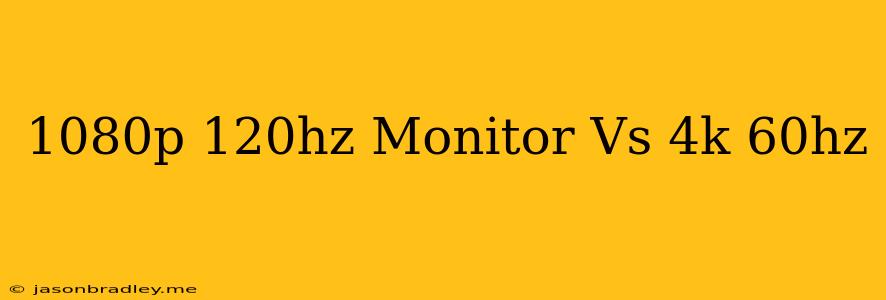1080p 120Hz vs 4K 60Hz: Which is Right for You?
Choosing a monitor can be a daunting task, especially with the abundance of options available. Two popular choices are 1080p 120Hz and 4K 60Hz monitors. Both offer distinct advantages, making it crucial to understand their differences to pick the one that best suits your needs.
1080p 120Hz: The Smoothness Champion
A 1080p 120Hz monitor offers a higher refresh rate compared to a 4K 60Hz monitor. This translates to smoother gameplay and reduced motion blur, making it ideal for fast-paced games and competitive gaming.
Here are the key benefits of a 1080p 120Hz monitor:
- Smooth gameplay: The high refresh rate provides a significantly smoother visual experience, especially during fast-paced action scenes.
- Reduced motion blur: The quick refresh rate minimizes blur, leading to clearer visuals and a more immersive gameplay.
- Lower cost: 1080p monitors are generally cheaper than 4K monitors.
- Better performance: A lower resolution demands less processing power, allowing you to achieve higher frame rates with the same graphics card.
However, there are some downsides to consider:
- Lower resolution: The 1080p resolution may feel less sharp and detailed compared to 4K.
- Less screen real estate: You'll have less space on screen for multitasking or viewing larger images.
4K 60Hz: The Visual Feast
A 4K 60Hz monitor offers a higher resolution than a 1080p 120Hz monitor. This translates to more detail and a sharper picture, perfect for content creation, photo editing, and enjoying high-quality movies and shows.
Here are the benefits of a 4K 60Hz monitor:
- Stunning detail: The 4K resolution provides an incredibly sharp and detailed picture, revealing intricate details you may miss on a 1080p screen.
- Immersive experience: The higher resolution creates a more immersive experience for watching movies and playing games.
- Future-proof: 4K is becoming the standard resolution, so investing in a 4K monitor sets you up for future content and technological advancements.
However, there are also downsides to consider:
- Lower refresh rate: The 60Hz refresh rate can lead to noticeable motion blur, especially in fast-paced games.
- Higher cost: 4K monitors are generally more expensive than 1080p monitors.
- Demanding hardware: 4K resolution requires more processing power from your graphics card to achieve smooth frame rates.
The Verdict: Which is Better?
Ultimately, the best monitor for you depends on your priorities and usage .
-
If you prioritize smooth gameplay and value a responsive, fast experience, a 1080p 120Hz monitor is the way to go.
-
If you prioritize image quality, detail, and a visually immersive experience, a 4K 60Hz monitor is the better choice.
Consider your budget, gaming preferences, and intended usage to make the right decision. There's no single "best" monitor; the ideal one is the one that best meets your individual needs.
